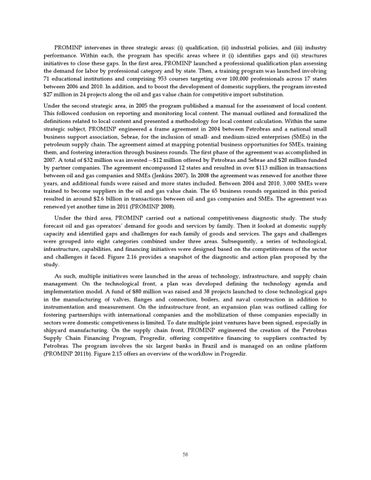PROMINP intervenes in three strategic areas: (i) qualification, (ii) industrial policies, and (iii) industry performance. Within each, the program has specific areas where it (i) identifies gaps and (ii) structures initiatives to close these gaps. In the first area, PROMINP launched a professional qualification plan assessing the demand for labor by professional category and by state. Then, a training program was launched involving 71 educational institutions and comprising 953 courses targeting over 100,000 professionals across 17 states between 2006 and 2010. In addition, and to boost the development of domestic suppliers, the program invested $27 million in 24 projects along the oil and gas value chain for competitive import substitution. Under the second strategic area, in 2005 the program published a manual for the assessment of local content. This followed confusion on reporting and monitoring local content. The manual outlined and formalized the definitions related to local content and presented a methodology for local content calculation. Within the same strategic subject, PROMINP engineered a frame agreement in 2004 between Petrobras and a national small business support association, Sebrae, for the inclusion of small- and medium-sized enterprises (SMEs) in the petroleum supply chain. The agreement aimed at mapping potential business opportunities for SMEs, training them, and fostering interaction through business rounds. The first phase of the agreement was accomplished in 2007. A total of $32 million was invested—$12 million offered by Petrobras and Sebrae and $20 million funded by partner companies. The agreement encompassed 12 states and resulted in over $113 million in transactions between oil and gas companies and SMEs (Jenkins 2007). In 2008 the agreement was renewed for another three years, and additional funds were raised and more states included. Between 2004 and 2010, 3,000 SMEs were trained to become suppliers in the oil and gas value chain. The 65 business rounds organized in this period resulted in around $2.6 billion in transactions between oil and gas companies and SMEs. The agreement was renewed yet another time in 2011 (PROMINP 2008). Under the third area, PROMINP carried out a national competitiveness diagnostic study. The study forecast oil and gas operators’ demand for goods and services by family. Then it looked at domestic supply capacity and identified gaps and challenges for each family of goods and services. The gaps and challenges were grouped into eight categories combined under three areas. Subsequently, a series of technological, infrastructure, capabilities, and financing initiatives were designed based on the competitiveness of the sector and challenges it faced. Figure 2.16 provides a snapshot of the diagnostic and action plan proposed by the study. As such, multiple initiatives were launched in the areas of technology, infrastructure, and supply chain management. On the technological front, a plan was developed defining the technology agenda and implementation model. A fund of $80 million was raised and 38 projects launched to close technological gaps in the manufacturing of valves, flanges and connection, boilers, and naval construction in addition to instrumentation and measurement. On the infrastructure front, an expansion plan was outlined calling for fostering partnerships with international companies and the mobilization of these companies especially in sectors were domestic competiveness is limited. To date multiple joint ventures have been signed, especially in shipyard manufacturing. On the supply chain front, PROMINP engineered the creation of the Petrobras Supply Chain Financing Program, Progredir, offering competitive financing to suppliers contracted by Petrobras. The program involves the six largest banks in Brazil and is managed on an online platform (PROMINP 2011b). Figure 2.15 offers an overview of the workflow in Progredir.
58
